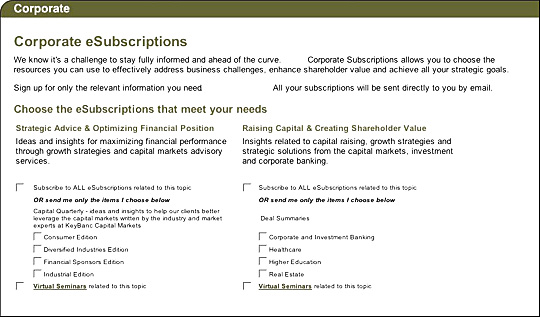|
June 2006
CRM and e-mail marketing—the dynamic duo
E-mail marketing has become a mature medium that, by all available indicators, is performing at or above expectations. But to produce even better e-mail campaign results, many financial services companies are integrating customer data with their e-mail solutions.
The tool for accomplishing this integration is customer relationship management (CRM) software.
The power of CRM
A 2005 Forrester Research report on Top Marketing Technologies found that "CRM software has reemerged as the basic business enabler ... and e-mail is the core enabling technology."
There's no question that the integration of a CRM system into an e-mail system can enable you to deliver highly targeted marketing communications. Or that these targeted communications can deliver a notably high and measurable return on investment (ROI).
In the report, "The ROI of E-mail Relevance," JupiterResearch found that targeted communications, or communications segmented by reader profile, can increase net profits an average of 18 times over "batch and blast" or one-size-fits-all style communications.
Topica (www.topica.com), an online marketing company, reports that this is particularly true when the list includes fewer than 5,000 names. Topica also found that in the case of e-newsletters, even simply segmenting your e-mail list by job title or by prospect vs. client can markedly improve results.
Addressing CRM challenges
Yet while most marketers would love to be able to do this kind of list segmentation, they often struggle to succeed. Many CRM systems, while fully capable of the task, carry with them an often daunting learning curve. This can make them somewhat difficult and cumbersome to use in a strategic fashion.
So what are your alternatives?
One is to use an affordable "proxy" or "mini" CRM system that is much more user friendly and easier to integrate with e-mail.
For instance, e-mail service providers like ExactTarget and eROI are now offering bundled CRM and e-mail solutions to address this growing dilemma. The CRM software utilizes "attribute fields," which mirror the fields in outgoing e-mail messages. These attributes—which might include job title, industry sector, number of employees, etc.—become filters that enable segmented lists for targeted messages. For instance, you could send an e-newsletter on procurement card services to your list of CFOs at larger corporations, and the same newsletter sent to manufacturing companies could incorporate an industrial case study.
Using these filters lets you personalize your message even further by incorporating the recipient's name in the subject line or headline, or even within the body of your message. Personalization can work just as well in reverse: You can tag the "from" line of your outgoing messages down to the specific calling officer. In the example below, the topic, the recipient's name and the sending calling officer's name have all been customized by using these combined technologies.
Preference centers
Another way to enable highly customized content is to offer clients an electronic form that allows them to choose precisely the kind of information they'd like to receive. The form, called a "preference center" or a subscription management page, contains multiple-choice options that also serve as attribute fields. Content selections might include: Cash Management, Investing, Global Trade and so forth.
Research indicates that recipients view such a la carte option pages as a customer service and are more receptive to such communications at much higher frequencies than they would be to more broad-based messages.
An example of a subscription management page is shown below:

Tracking through calls to action
Segmented e-mail lists of less than 5,000 names also enjoy much higher click-through rates than non-segmented lists. In the same Topica study noted above, click-through rates in a cross section of industries increased from less than 1% to nearly 12% when lists were segmented. This is especially encouraging for banks. A 2005 e-mail statistics report by MailerMailer found that e-mails from banking institutions had the second-highest click-through rates—an average of 8.64%—among the 21 industry sectors tested. Government e-mails ranked first with 9.18% click-throughs. Other major industry segments surveyed included Computers (8.32%), Retail (7.75%) and Manufacturing (7.34%).
Such a dramatic increase in reader activity serves as a great incentive for e-mailers to incorporate call-to-action links in their messages. Calls to action don't necessarily need to be overtly promotional or sales oriented. In the case of thought-leadership style e-mail messages, such as a newsletter, the call to action may simply be an invitation to download a relevant white paper, view an online demonstration or link to a designated landing page.
The important points to remember here are that clicking through and selecting content are both very positive customer-initiated activities, and customer-initiated marketing messages consistently outperform messages initiated by the sender.
. . .
FPS regularly works with financial services companies to maximize the impact of their client communications, including e-mail and online communications. To find out how we can help you develop effective strategies for communicating with corporate financial executives, contact FPS President Vince DiPaolo at 847-501-4120 or [email protected]. You can also write him at the following address:
Financial Publishing Services Co.
464 Central Avenue
Suite 8
Northfield, IL 60093
If you are not already a MarketScope subscriber, please request your own free monthly edition.
|


